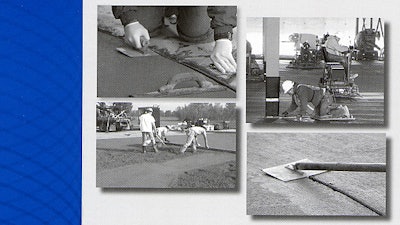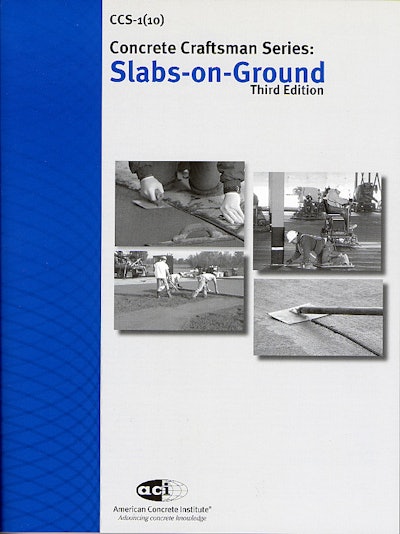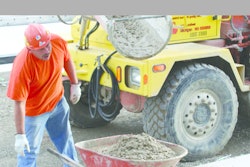
The American Concrete Institute (ACI) produces hundreds of documents dedicated to improving the design, construction, maintenance, and repair of concrete and masonry structures. ACI documents are developed in numerous types and formats, including standards (design codes and construction specifications), handbooks and manuals, certification documents, and education documents. As part of the Institute's Concrete Craftsman series, updates to CCS-1(10) Slabs-on-Ground includes information on placing with laser-guided screeds and finishing with walk-behind and riding power equipment.
While standardization is the most rigorous consensus process used by ACI, education documents are practice-oriented tools intended to raise the competence level of concrete producers, contractors, technicians, engineers, and others. Education documents use ACI technical documents as a basis, supplementing them as necessary, to produce resources that are intended for a wider audience.
One group of ACI education documents that has been gaining in popularity over the years is the Concrete Craftsman series. The series is a useful guide and training resource for craftsmen and contractors, especially those interested in earning credentials by becoming ACI certified. It is also of interest to persons who are peripherally involved with the concrete industry, such as material supplier representatives or inexperienced engineers who are looking to increase their knowledge of construction materials. Titles in the series include Concrete Fundamentals, Slabs-on-Ground, Shotcrete for the Craftsman, Supported Beams and Slabs and Placing and Finishing Decorative Concrete Flatwork.
Find more details on these additional publications below.Focus on CCS-1(10) Slabs-on-Ground
 American Concrete Institute
American Concrete Institute
CCS-1(10) Slabs-on-Ground focuses on the impact concrete finishers can have on slab quality. The most recent edition was updated with information to include placing with laser-guided screeds and finishing with walk-behind and riding power equipment.
The document covers the following:
- Slab-on-Ground Planning—CCS-1(10) Slabs-on-Ground discusses factors to consider when determining appropriate placement size, including variables in production rates, weather, and operator experience. It explains the way concrete quantities are calculated, along with other details that assist in ordering concrete and lays out requirements for handling concrete delivery. Discussion of crew size, required on-site equipment and procedures to follow during preconstruction meetings further help the reader understand how the first phase of concrete slab placement should proceed.
- Basic Concrete Materials, Mixture Proportioning, and Testing—CCS-1(10) Slabs-on-Ground Chapter 2 briefly explains concrete materials (including supplementary cementitious materials and admixtures), how they are combined in mixture proportioning to obtain fresh and hardened concrete properties, and how to measure those properties with control tests.
- Preparation before Concrete Placement—Even the best finishing methods can’t compensate for placing concrete on an underprepared surface, so CCS-1(10) Slabs-on-Ground details how to prepare and compact the subgrade; accomplish elevation control; determine the placement sequence; set side forms, temporary bulkheads, and screed guides; install vapor retarders and/or reinforcement (if required); lay out and mark joint locations on forms, and have a checklist to ensure the necessary tools and materials are ready.
- Floor Flatness and Levelness—Floor flatness, or smoothness, is important when wheeled vehicles will operate on a slab. It is also important for floors where thin vinyl sheet goods or polishing will be installed. These situations are increasingly common as big box stores and warehouses proliferate. Levelness describes the slope of a concrete slab. Floor slopes can be required (for example, to encourage water drainage) or they may need to be limited (for example, if high stacks of products are to be stored on the floor).
Construction specifications typically indicate concrete flatness and levelness requirements. CCS-1(10) Slabs-on-Ground explains how to measure floor flatness and levelness. It also addresses areas of concern when constructing floors to tight requirements. - Placing and Finishing Equipment—CCS-1(10) Slabs-on-Ground Chapter 5 points out the importance of placing concrete without delays and without changing the concrete properties, in order to best facilitate proper concrete finishing. Methods discussed include direct placement from truck mixers as well as placement from manual or motorized buggies, both of which are appropriate for placements close to ground level. For multistory buildings, crane and bucket placement, concrete conveyors and pumps are common placement methods defined in the document.
Tools used by laborers to complete placement and achieve finishing include spreading tools, consolidating or vibrating tools, and screeds. After placement, floats, trowels, and straightedges may be used for smoothing the concrete. Jointing and edging tools, as well as power saws, may be used to install contraction joints. A broad selection of such tools are pictured, and their use explained, in CCS-1(10) Slabs-on-Ground Chapter 6.
Once readers are familiar with placing and finishing tools, CCS-1(10) Slabs-on-Ground details how the tools should be used, and in which applications. Considerations such as waiting periods and managing bleed water are included. - Jointing—Concrete slabs are jointed to control cracking associated with the material’s shrinkage as it dries. CCS-1(10) Slabs-on-Ground describes the basic types of joints used as well as how to install them. The benefits of joint filling, along with sealant types and installation steps, are also covered.
- Concrete Curing and Protection—Curing refers to methods used to keep concrete moist and at the temperature needed to develop the required strength, wear resistance, and durability. Climate conditions—especially temperature—heavily influence curing procedures and timing. Methods such as ponding, sprinkling, covering with film or mats, and the use of curing compounds are outlined.
- Finishing Problems and Solutions—The final chapter of CCS-1(10) Slabs-on-Ground lists common difficulties that can be encountered during concrete finishing. Notable issues include excessive or insufficient bleeding, problems with setting, and surface issues such as crusting, blistering, delamination or stickiness. Weather-related challenges, such as placing in the rain, are addressed. Cracking, discoloration, dusting (the development of a powdery material), curling, scaling and more may afflict hardened concrete. Recommendations for mitigating these outcomes are offered in the document.
Information in CCS-1(10) Slabs-on-Ground should be used as a guide to good practices. The document does not supersede the provisions in the plans and specifications for any project. If provisions in plans and specifications vary from the guidance given in the document, variances should be discussed with the design professional. For more detailed information, ACI 302.1R: “Guide for Concrete Floor and Slab Construction” is a useful reference. Other reference documents are listed in the Concrete Craftsman manual. For more information or to purchase CCS-1(10) Slabs-on-Ground in print or digital PDF formats, visit concrete.org.
About the author
Michael L. Tholen is the Managing Director, Engineering and Professional Development, American Concrete Institute.








![[VIDEO] ACI Adds Two New Books to Concrete Craftsman Series](https://img.forconstructionpros.com/files/base/acbm/fcp/image/2016/02/default.56b26518d23a8.png?auto=format%2Ccompress&fit=crop&h=167&q=70&w=250)










